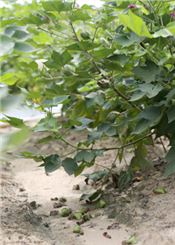|
Good Crop Expected Despite Dropped Bolls

Most cotton bolls lost to rainy, wet weather in early August were the younger ones
in the middle to upper part of the plant. Cotton, such as this growing Aug. 18, 2016,
on the Mississippi State University R.R. Foil Plant Research Center in Starkville,
is expected to yield a better than average harvest.
Photo by MSU Extension Service/Kat Lawrence
STARKVILLE, MISS.
Wet, cloudy weather has put a lot of cotton bolls on the ground, but experts still expect an above average crop from Mississippi’s cotton acreage.
Darrin Dodds, cotton specialist with the Mississippi State University Extension Service, said experts knew boll loss was coming after all the recent rain.
“By the last week of July to early August, a lot of cotton was retaining 85 to 90 percent or more of its total fruit,” Dodds said. “There are parts of the world where cotton can retain that high a percentage of bolls, but it’s not going to happen here. We normally retain 50 to 60 percent of the bolls that are set.”
Dodds said most of the bolls lost in early August were the younger pods in the middle to upper part of the plant.
“There’s nothing a grower can do about that, and it essentially boils down to how much fruit can a plant produce,” he said. “The plant will protect the bolls in the innermost positions close to the bottom of the plant.”
The U.S. Department of Agriculture estimated that 74 percent of the cotton crop was in fair to good condition by Aug. 14, with 16 percent looking excellent. The maturity level was average for the last five years, and the crop’s yield potential remains strong.
“I think we’re still going to pick a good crop,” Dodds said. “It may not be the 1,230-pound crop like we had a few years ago, but if we finish the rest of the year strong and the weather cooperates, it won’t be 900 pounds an acre, either.”
Target spot is a fungal disease that has affected cotton more this year than in the past. Tom Allen, Extension plant pathologist and Mississippi Agricultural and Forestry Experiment Station researcher, said the disease typically defoliates the lower to middle canopy.
“Lots of moisture and lots of humidity make for good fungal conditions,” Allen said. “Once the disease gets started in a field, it’s not really possible to make a fungicide application to slow the disease or prevent defoliation.”
Dodds said thrips were a problem in cotton early in the season, with higher numbers of this pest than have been seen in recent years. Pressure from plant bugs, typically the biggest problem for cotton in the Delta, was lighter this year than in previous years. Spider mites caused problems in some areas, but growers were able to manage these pests.
Some cotton harvest is expected to begin by the third week of September, with harvest fully underway by the first of October. Cotton harvest typically finishes in early November.
“Early indications are that cotton acres may increase next year,” Dodds said.
Cotton prices are part of what is driving increased interest in the crop for next year. Brian Williams, Extension agricultural economist, said October cotton prices are just over 68 cents a pound, with south Delta cash prices just under 67 cents a pound. Cash cotton was around 65 cents a pound at this time last year.
“Prices have been on a downward trend for the last couple of weeks,” Williams said. “In early August, cash cotton was over 76 cents a pound, and futures peaked at just over 77 cents a pound. If you don’t count the run-up in prices we saw in the last few weeks, cotton is still at the highest point in over two years.”
Williams said there is a lot of uncertainty in cotton markets right now.
“A lot of traders are watching west Texas to see what kind of a crop they will have, since they are in the midst of another drought, but the current downward trend is more of a market correction,” he said. ∆
|
|